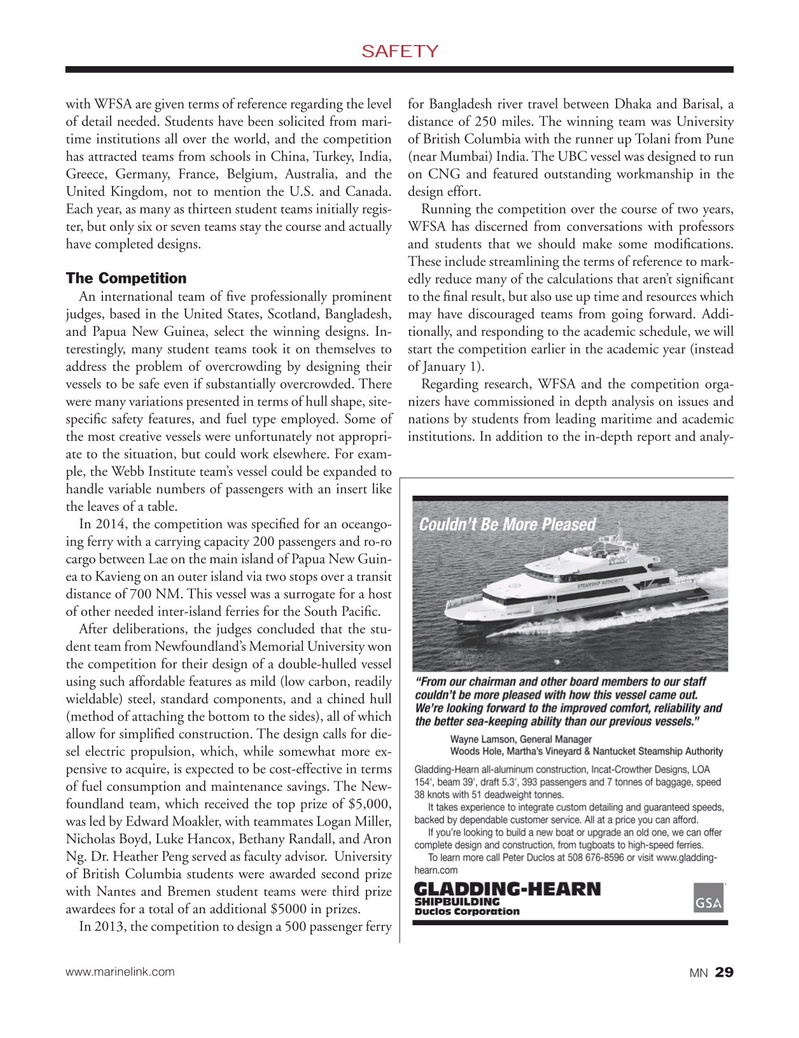
Page 29: of Marine News Magazine (January 2015)
Passenger Vessels & Ferries
Read this page in Pdf, Flash or Html5 edition of January 2015 Marine News Magazine
SAFETY with WFSA are given terms of reference regarding the level for Bangladesh river travel between Dhaka and Barisal, a of detail needed. Students have been solicited from mari- distance of 250 miles. The winning team was University time institutions all over the world, and the competition of British Columbia with the runner up Tolani from Pune has attracted teams from schools in China, Turkey, India, (near Mumbai) India. The UBC vessel was designed to run
Greece, Germany, France, Belgium, Australia, and the on CNG and featured outstanding workmanship in the
United Kingdom, not to mention the U.S. and Canada. design effort.
Each year, as many as thirteen student teams initially regis- Running the competition over the course of two years, ter, but only six or seven teams stay the course and actually WFSA has discerned from conversations with professors have completed designs. and students that we should make some modi? cations.
These include streamlining the terms of reference to mark-
The Competition edly reduce many of the calculations that aren’t signi? cant
An international team of ? ve professionally prominent to the ? nal result, but also use up time and resources which judges, based in the United States, Scotland, Bangladesh, may have discouraged teams from going forward. Addi- and Papua New Guinea, select the winning designs. In- tionally, and responding to the academic schedule, we will terestingly, many student teams took it on themselves to start the competition earlier in the academic year (instead address the problem of overcrowding by designing their of January 1).
vessels to be safe even if substantially overcrowded. There Regarding research, WFSA and the competition orga- were many variations presented in terms of hull shape, site- nizers have commissioned in depth analysis on issues and speci? c safety features, and fuel type employed. Some of nations by students from leading maritime and academic the most creative vessels were unfortunately not appropri- institutions. In addition to the in-depth report and analy- ate to the situation, but could work elsewhere. For exam- ple, the Webb Institute team’s vessel could be expanded to handle variable numbers of passengers with an insert like the leaves of a table.
In 2014, the competition was speci? ed for an oceango- ing ferry with a carrying capacity 200 passengers and ro-ro cargo between Lae on the main island of Papua New Guin- ea to Kavieng on an outer island via two stops over a transit distance of 700 NM. This vessel was a surrogate for a host of other needed inter-island ferries for the South Paci? c.
After deliberations, the judges concluded that the stu- dent team from Newfoundland’s Memorial University won the competition for their design of a double-hulled vessel using such affordable features as mild (low carbon, readily wieldable) steel, standard components, and a chined hull (method of attaching the bottom to the sides), all of which allow for simpli? ed construction. The design calls for die- sel electric propulsion, which, while somewhat more ex- pensive to acquire, is expected to be cost-effective in terms of fuel consumption and maintenance savings. The New- foundland team, which received the top prize of $5,000, was led by Edward Moakler, with teammates Logan Miller,
Nicholas Boyd, Luke Hancox, Bethany Randall, and Aron
Ng. Dr. Heather Peng served as faculty advisor. University of British Columbia students were awarded second prize with Nantes and Bremen student teams were third prize awardees for a total of an additional $5000 in prizes.
In 2013, the competition to design a 500 passenger ferry www.marinelink.com
MN 29
MN Jan15 Layout 18-31.indd 29 MN Jan15 Layout 18-31.indd 29 12/22/2014 2:44:30 PM12/22/2014 2:44:30 PM

 28
28

 30
30
